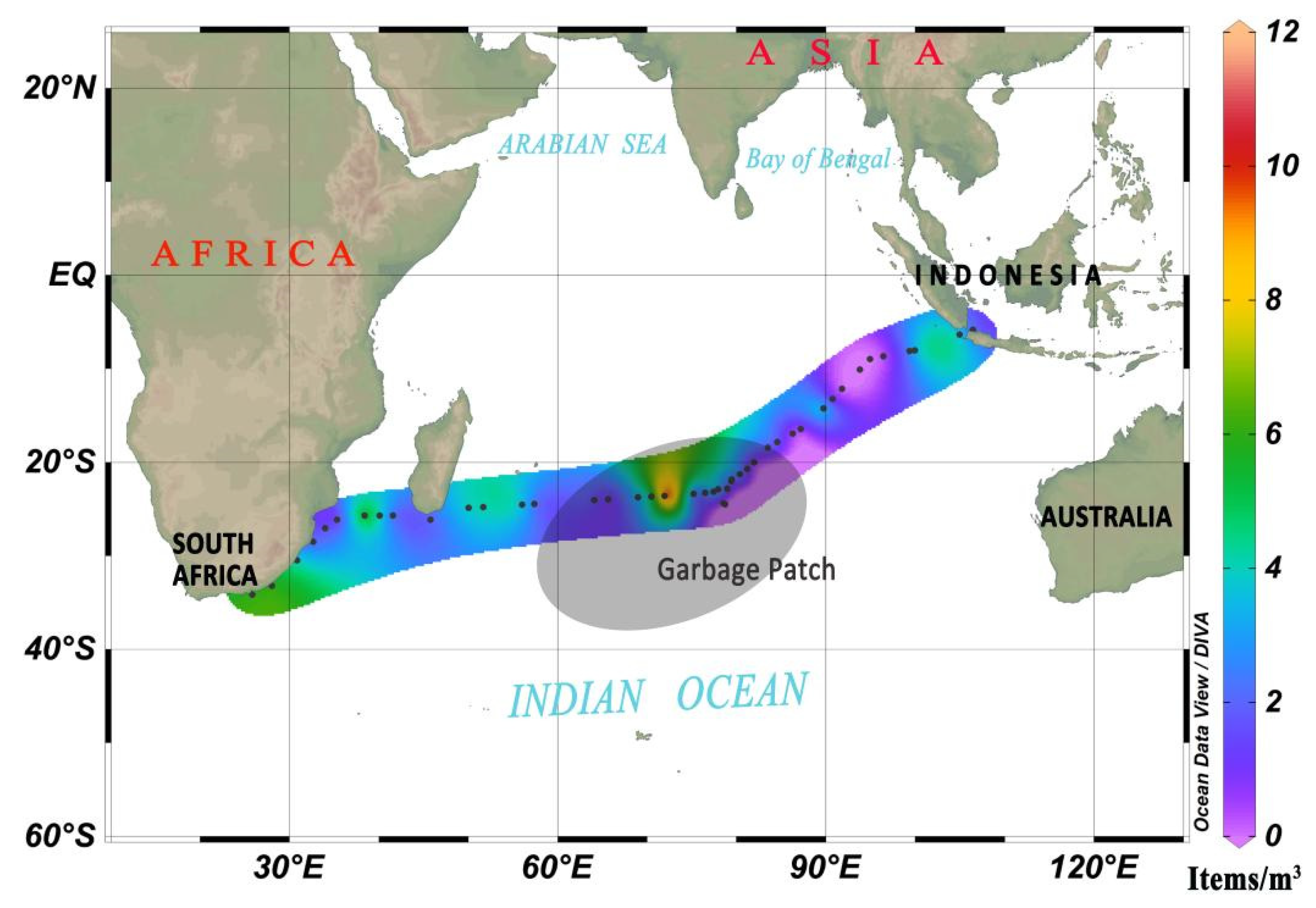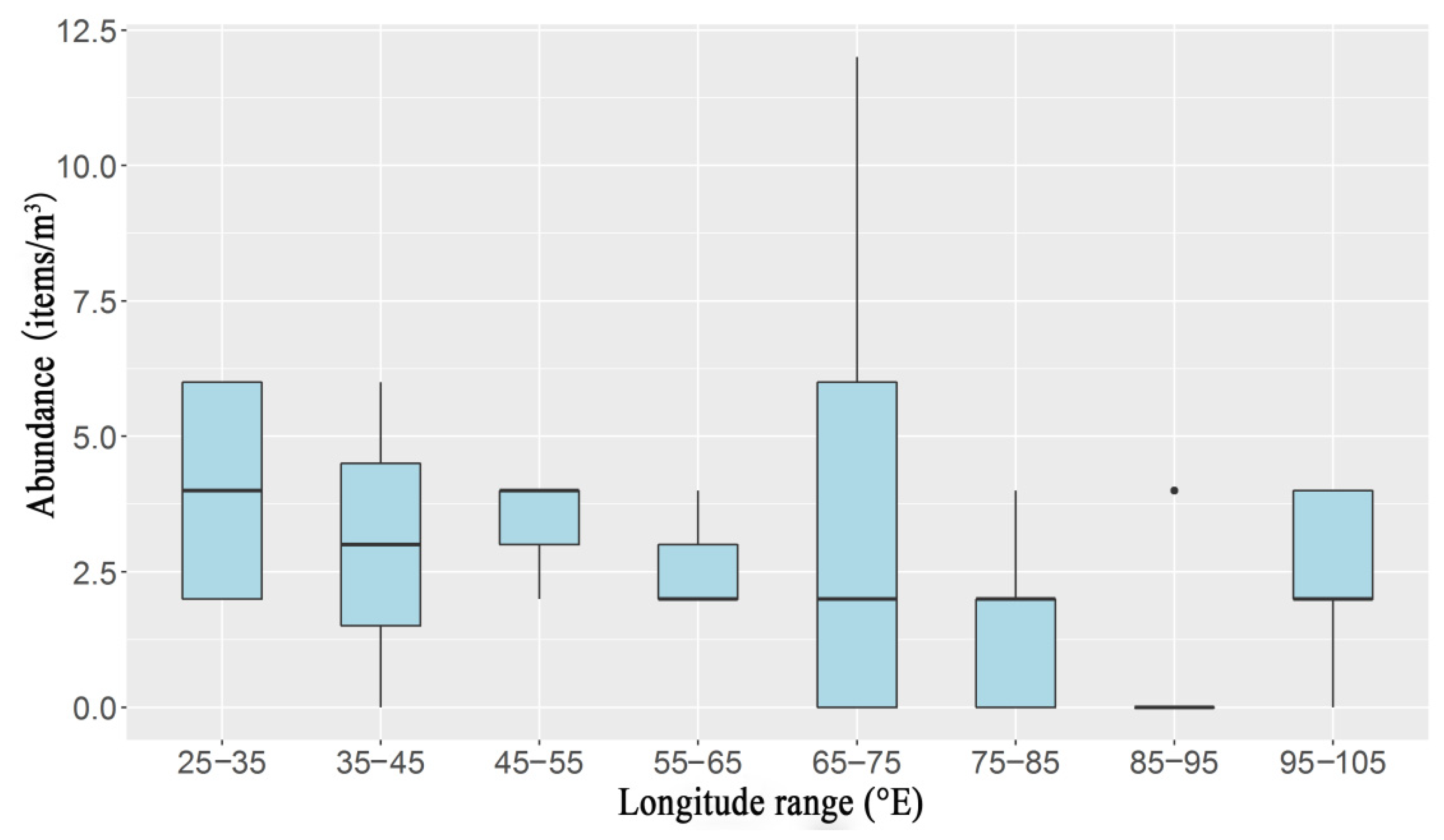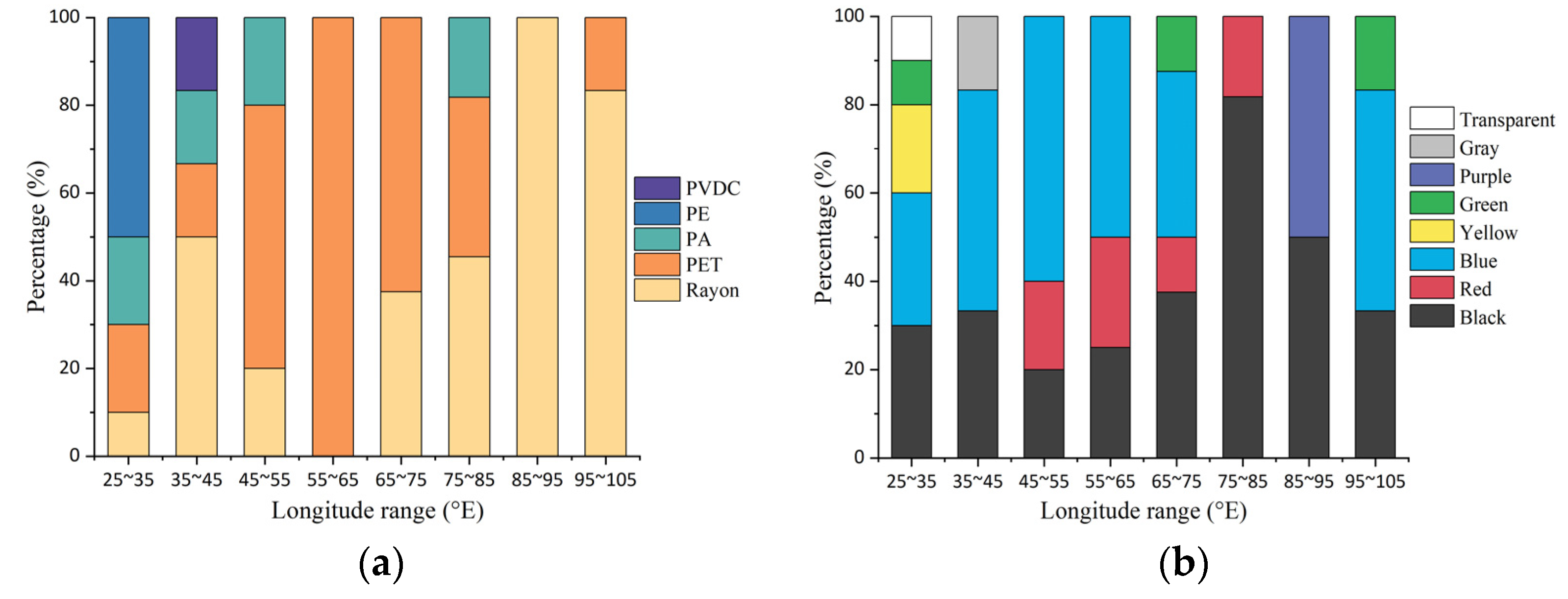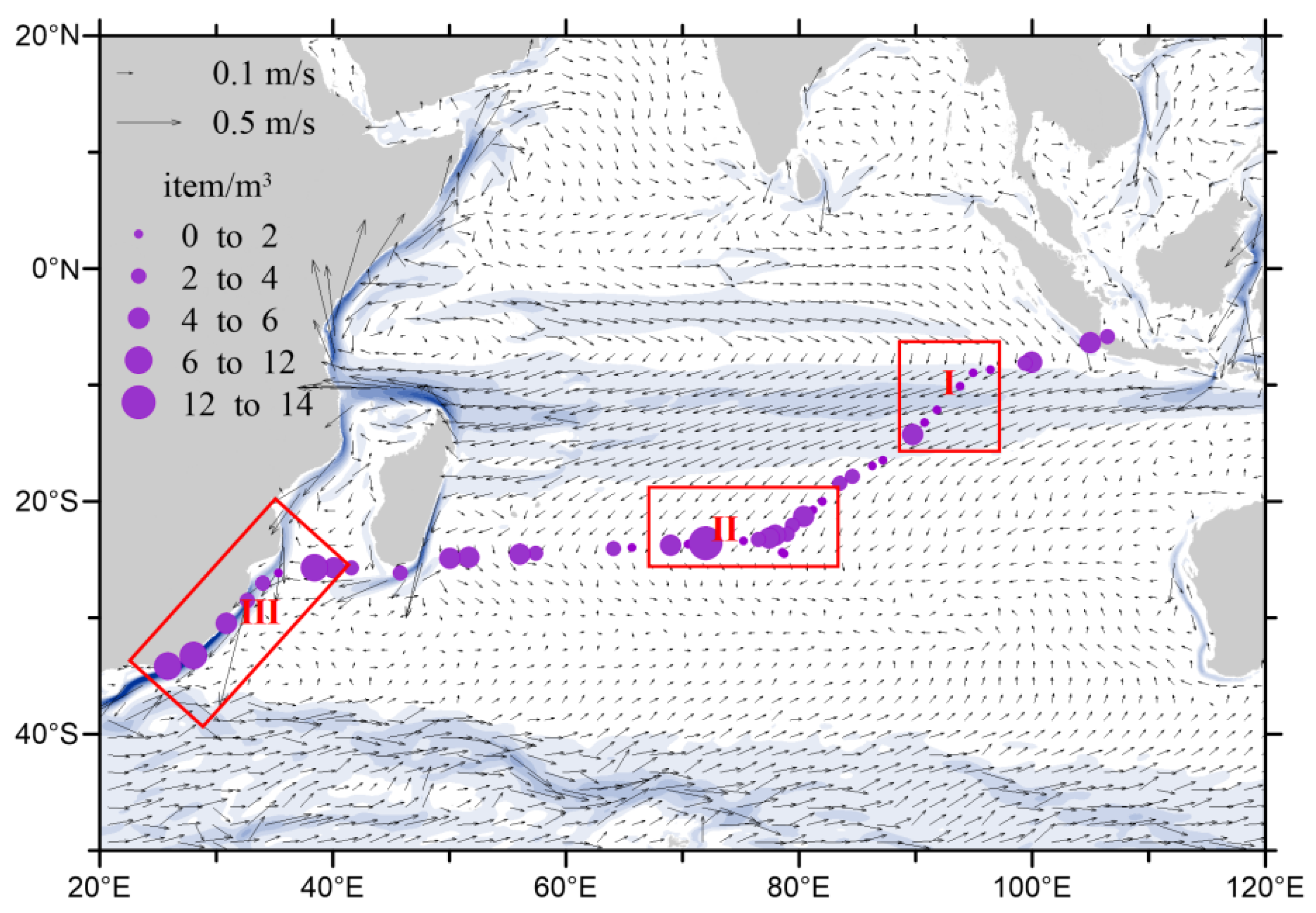Zonal Distribution Characteristics of Microplastics in the Southern Indian Ocean and the Influence of Ocean Current
Abstract
:1. Introduction
2. Materials and Methods
2.1. Sample Collection and Pretreatment of Microplastics
2.2. Qualitative and Quantitative Methods for Microplastics
2.3. Data Analysis Method and Quality Control
3. Results and Discussion
3.1. Analysis of Zonal Distribution Characteristics of Microplastics in the Southern Indian Ocean
3.1.1. Abundance and Characteristics of Microplastics
3.1.2. Spatial Distribution Analysis of Microplastics
3.1.3. Comparison of Microplastics in Different Ocean Waters
3.2. Effects of Ocean Currents on the Distribution of Microplastics in the Indian Ocean
4. Conclusions
Author Contributions
Funding
Institutional Review Board Statement
Informed Consent Statement
Data Availability Statement
Conflicts of Interest
References
- Jambeck, J.R.; Geyer, R.; Wilcox, C.; Siegler, T.R.; Perryman, M.; Andrady, A.; Narayan, R.; Law, K.L. Plastic waste inputs from land into the ocean. Science 2015, 347, 768–771. [Google Scholar] [CrossRef]
- Moore, C.J.; Moore, S.L.; Leecaster, M.K.; Weisberg, S.B. A comparison of plastic and plankton in the north Pacific central gyre. Mar. Pollut. Bull. 2001, 42, 1297–1300. [Google Scholar] [CrossRef]
- Law, K.L.; Morét-Ferguson, S.E.; Goodwin, D.S.; Zettler, E.R.; Deforce, E.; Kukulka, T.; Proskurowski, G. Distribution of surface plastic debris in the eastern Pacific Ocean from an 11-year data set. Environ. Sci. Technol. 2014, 48, 4732–4738. [Google Scholar] [CrossRef]
- Barnes, D.K. A Natural and plastic flotsam stranding in the Indian ocean. J. R. Ir. Acad. 2004, 3, 193–205. [Google Scholar]
- Law, K.L.; Morétferguson, S.; Maximenko, N.A.; Proskurowski, G.; Peacock, E.E.; Hafner, J.; Reddy, C.M. Plastic accumulation in the North Atlantic subtropical gyre. Science 2010, 329, 1185–1188. [Google Scholar] [CrossRef] [Green Version]
- Cózar, A.; Echevarría, F.; González-Gordillo, J.I.; Irigoien, X.; Duarte, C.M. Plastic debris in the open ocean. Proc. Natl. Acad. Sci. USA 2014, 111, 10239–10244. [Google Scholar] [CrossRef] [Green Version]
- Thompson, R.C.; Olsen, Y.; Mitchell, R.P.; Mitchell, R.P.; Davis, A.; Rowland, S.J.; John, A.W.G.; Mcgonigle, d.; Russell, A.E. Lost at Sea: Where Is All the Plastic? Science 2004, 304, 838. [Google Scholar] [CrossRef]
- Gouin, T.; Roche, N.; Lohmann, R.; Hodges, G. A thermodynamic approach for assessing the environmental exposure of chemicals absorbed to microplastic. Environ. Sci. Technol. 2011, 45, 1466–1472. [Google Scholar] [CrossRef]
- Brennecke, D.; Duarte, B.; Paiva, F.; Caçador, I.; Canning-Clode, J. Microplastics as vector for heavy metal contamination from the marine environment. Estuar. Coast. Shelf Sci. 2016, 178, 189–195. [Google Scholar] [CrossRef]
- Teuten, E.L.; Saquing, J.M.; Knappe, D.R.U.; Barlaz, M.A.; Jonsson, S.; Bjorn, A.; Rowland, S.J.; Thompson, R.C.; Galloway, T.S.; Yamashita, R. Transport and release of chemicals from plastics to the environment and to wildlife. Philos. Trans. R. Soc. B Biol. Sci. 2009, 364, 2027–2045. [Google Scholar] [CrossRef] [Green Version]
- Wang, J.Y.; Lin, X.Z. Global ocean governance in addressing plastic and microplastic pollution. Pac. J. 2018, 4, 79–87. [Google Scholar]
- Li, D.J.; Zhu, L.X.; Chang, S.Y.; Zhang, F.; Wang, L. State of marine microplastic pollution research and the limitations. J. East China Norm. Univ. 2019, 3, 174–185. [Google Scholar]
- Sun, C.J.; Jiang, F.H.; Li, J.X.; Zheng, L. The Research Progress in Source, Distribution, Ecological and Environmental Effects of Marine Microplastics. Adv. Mar. Sci. 2016, 34, 449–461. [Google Scholar]
- Zhao, Z.K.; Zhao, L.R.; Chen, C.L.; Sheng, K.E.; Zhang, J.B.; Liang, Y.Q. Research status and problems of marine microplastics. J. Guangdong Ocean Univ. 2018, 38, 99–106. [Google Scholar]
- Auta, H.S.; Emenike, C.U.; Fauziah, S.H. Distribution and importance of microplastics in the marine environment: A review of the sources, fate, effects, and potential solutions. Environ. Int. 2017, 102, 165–176. [Google Scholar] [CrossRef]
- Goldstein, M.C.; Rosenberg, M.; Cheng, L. Increased oceanic microplastic debris enhances oviposition in an endemic pelagic insect. Biol. Lett. 2012, 8, 817–820. [Google Scholar] [CrossRef] [Green Version]
- Collignon, A.; Hecq, J.H.; Glagani, F.; Voisin, P.; Goffart, A. Neustonic microplastic and zooplankton in the North Western Mediterranean Sea. Mar. Pollut. Bull. 2012, 64, 861–864. [Google Scholar] [CrossRef] [Green Version]
- Abayomi, O.A.; Range, P.; Al-Ghouti, M.A.; Obbard, J.P.; Almmer, S.H.; Ben-Hamadou, R. Microplastics in coastal environments of the Arabian Gulf. Mar. Pollut. Bull. 2017, 124, 181–188. [Google Scholar] [CrossRef]
- Zhang, W.W.; Zhang, S.F.; Wang, J.Y.; Wang, Y.; Mu, J.L. Microplastic pollution in the surface waters of the Bohai Sea, China. Environ. Pollut. 2017, 231, 541–548. [Google Scholar] [CrossRef]
- Dai, Z.F.; Zhang, H.B.; Zhou, Q.; Tian, Y.; Chen, T.; Tu, C.; Fu, C.C.; Luo, Y.M. Occurrence of microplastics in the water column and sediment in an inland sea affected by intensive anthropogenic activities. Environ. Pollut. 2018, 242, 1557–1565. [Google Scholar] [CrossRef]
- Zhu, L.; Bai, H.Y.; Chen, B.J.; Sun, X.M.; Qu, K.M.; Xia, B. Microplastic pollution in North Yellow Sea, China: Observations on occurrence, distribution and identification. Sci. Total Environ. 2018, 636, 20–29. [Google Scholar] [CrossRef]
- Zhao, S.Y.; Zhu, L.X.; Wang, T.; Li, D.J. Suspended microplastics in the surface water of the Yangtze Estuary System, China: First observations on occurrence, distribution. Mar. Pollut. Bull. 2014, 86, 562–568. [Google Scholar] [CrossRef]
- Peng, G.Y.; Zhu, B.S.; Yang, D.Q.; Su, L.; Shi, H.H.; Li, D.J. Microplastics in sediments of the Changjiang Estuary, China. Environ. Pollut. 2017, 225, 283–290. [Google Scholar] [CrossRef]
- Zhang, K.; Xiong, X.; Hu, H.J.; Wu, C.X.; Bi, Y.H.; Wu, Y.H.; Zhou, B.S.; Kwan-Sing, P.; Lam, J.T.; Wu, Y.H.; et al. Occurrence and characteristics of microplastic pollution in Xiangxi Bay of Three Gorges Reservoir, China. Environ. Sci. Technol. 2017, 51, 3794–3801. [Google Scholar] [CrossRef]
- Sun, X.X.; Liu, T.; Zhu, M.L.; Liang, J.H.; Zhao, Y.F.; Zhang, B. Retention and characteristics of microplastics in natural zooplankton taxa from the East China Sea. Sci. Total Environ. 2018, 640, 232–242. [Google Scholar] [CrossRef]
- Zhou, P.; Huang, C.G.; Fang, H.D.; Cai, W.X.; Li, D.M.; Li, X.M.; Yu, H.S. The abundance, composition and sources of marine debris in coastal seawaters or beaches around the northern South China Sea (China). Mar. Pollut. Bull. 2011, 62, 1998–2007. [Google Scholar] [CrossRef]
- Sun, X.X.; Li, Q.J.; Zhu, M.L.; Liang, J.H.; Zheng, S.; Zhao, Y.F. Ingestion of microplastics by natural zooplankton groups in the northern South China Sea. Mar. Pollut. Bull. 2017, 115, 217–224. [Google Scholar] [CrossRef]
- Cai, M.G.; He, H.X.; Liu, M.Y.; Li, S.W.; Tang, G.W.; Wang, W.M.; Huang, P.; Wei, G.; Lin, Y.; Chen, B.; et al. Lost but can’t be neglected: Huge quantities of small microplastics hide in the South China Sea. Sci. Total Environ. 2018, 633, 1206–1216. [Google Scholar] [CrossRef]
- Lusher, A.L.; Tirelli, V.; O’connor, I.; Officer, R. Microplastics in Arctic polar waters: The first reported values of particles in surface and sub-surface samples. Sci. Rep. 2015, 5, 14947. [Google Scholar] [CrossRef] [Green Version]
- Wang, S.M.; Chen, H.Z.; Zhou, X.W.; Tian, Y.Q.; Lin, C.; Wang, W.L.; Zhou, K.W.; Zhang, Y.B.; Lin, H. Microplastic abundance, distribution and composition in the mid-west Pacific Ocean. Environ. Pollut. 2020, 264, 114125. [Google Scholar] [CrossRef]
- Schott, F.A.; McCreary, J.P. The monsoon circulation of the Indian Ocean. Prog. Oceanogr. 2001, 51, 1–123. [Google Scholar] [CrossRef]
- Garternicht, U.; Schott, F. Heat fluxes of the Indian Ocean from a global eddy-resolving model. J. Geophys. Res. 1994, 21, 147–159. [Google Scholar] [CrossRef] [Green Version]
- Wang, Y.; Cui, F.J. The structure and seasonal variation of upper-lakyer currents at central equatorial Indian ocean. Oceanol. Limnol. Sin. 2015, 46, 241–247. [Google Scholar]
- Jia, X.L.; Li, C.Y. Dipole oscillation in the Southern Indian Ocean and its impacts on climate. Chin. J. Geophys. 2005, 48, 1238–1249. [Google Scholar] [CrossRef]
- Connan, M.; Perold, V.; Dilley, B.J.; Barbraud, C.; Ryan, P.G. The Indian Ocean ‘garbage patch’: Empirical evidence from floating macro-litter. Mar. Pollut. Bull. 2021, 169, 112559. [Google Scholar] [CrossRef]
- Miraji, H.; Ripanda, A.; Moto, E. A review on the occurrences of persistent organic pollutants in corals, sediments, fish and waters of the Western Indian Ocean. Egypt J. Aquat. Res. 2021, 47, 373–379. [Google Scholar] [CrossRef]
- Hidalgo-Ruz, V.; Gutow, L.; Thompson, R.C.; Thiel, M. Microplastics in the marine environment: A review of the methods used for identification and quantification. Environ. Sci. Technol. 2012, 46, 3060–3075. [Google Scholar] [CrossRef]
- Browne, M.A.; Crump, P.; Niven, S.J.; Teuten, E.; Tonkin, A.; Galloway, T.; Thompson, R.C. Accumulation of microplastic on shorelines woldwide: Sources and sinks. Environ. Sci. Technol. 2011, 45, 9175–9179. [Google Scholar] [CrossRef]
- Gies, E.A.; LeNoble, J.L.; Noël, M.; Etemadifar, A.; Bishay, F.; Hall, E.R.; Ross, P.S. Retention of microplastics in a major secondary wastewater treatment plant in Vancouver, Canada. Mar. Pollut. Bull. 2018, 133, 553–561. [Google Scholar] [CrossRef]
- Liu, K.; Wang, X.H.; Fang, T.; Xu, P.; Zhu, L.X. Source and potential risk assessment of suspended atmospheric microplastics in Shanghai. Sci. Total Environ. 2019, 675, 462–471. [Google Scholar] [CrossRef]
- Dris, R.; Gasperi, J.; Saad, M.; Mirande-Bret, C.; Tassin, B. Synthetic fibers in atmospheric fallout: A source of microplastics in the environment? Mar. Pollut. Bull. 2016, 104, 290–293. [Google Scholar] [CrossRef]
- Boucher, J.; Friot, D. Primary Microplastics in the Oceans: A Global Evaluation of Sources; IUCN: Gland, Switzerland, 2017. [Google Scholar]
- Chen, G.X.; Han, W.Q.; Li, Y.L.; McPhaden, M.J.; Chen, J.; Wang, W.Q.; Wang, D.X. Strong intraseasonal variability of meridional currents near 5° N in the eastern Indian Ocean: Characteristics and causes. J. Phys. Oceanogr. 2017, 47, 979–998. [Google Scholar] [CrossRef]
- Xuan, L.L.; Qiu, Y.; Xu, J.D.; Zeng, M.Z. Seasonal variation of surface-layer circulation in the eastern tropical Indian Ocean. J. Trop. Oceanogr. 2014, 33, 26–35. [Google Scholar]
- Mason, S.A.; Garneau, D.; Sutton, R.; Chu, Y.; Ehmann, K.; Barnes, J.; Fink, P.; Papazissimos, D.; Rogers, D.L. Microplastic pollution is widely detected in US municipal wastewater treatment plant effluent. Environ. Pollut. 2016, 218, 1045–1054. [Google Scholar] [CrossRef]
- Sun, J.; Dai, X.H.; Wang, Q.L.; Mark, C.M.; Loosdrecht, V.; Ni, B.J. Microplastics in wastewater treatment plants: Detection, occurrence and removal. Water Res. 2019, 152, 21–37. [Google Scholar] [CrossRef]
- Cole, M.; Lindeque, P.; Halsband, C.; Galloway, T.S. Microplastics as contaminants in the marine environment: A review. Mar. Pollut. Bull. 2011, 62, 2588–2597. [Google Scholar] [CrossRef]
- Browne, M.A. Sources and Pathways of Microplastics to Habitats. In Marine Anthropogenic Litter; Springer: Berlin/Heidelberg, Germany, 2015. [Google Scholar]
- Nel, H.A.; Froneman, P.W. A quantitative analysis of microplastic pollution along the south-eastern coastline of South Africa. Mar. Pollut. Bull. 2015, 101, 274–279. [Google Scholar] [CrossRef]
- Li, C.J.; Zhu, L.X.; Wang, X.H.; Liu, L.; Li, D.J. Cross-oceanic distribution and origin of microplastics in the subsurface water of the South China Sea and Eastern Indian Ocean. Sci. Total Environ. 2022, 805, 150243. [Google Scholar] [CrossRef]
- Catarino, A.I.; Thompson, R.; Sanderson, W.; Henry, T.B. Development and optimization of a standard method for extraction of microplastics in mussels by enzyme digestion of soft tissues. Environ. Toxicol. Chem. 2017, 36, 947–951. [Google Scholar] [CrossRef]
- Ding, J.F.; Li, J.X.; Sun, C.J.; Jiang, F.H.; Ju, P.; Qu, L.Y.; Zheng, Y.F.; He, C.F. Detection of microplastics in local marine organisms using a multi-technology system. Anal. Methods. 2018, 11, 78–87. [Google Scholar] [CrossRef]
- Lusher, A.L.; Burke, A.; O’Connor, I.; Officer, R. Microplastic pollution in the Northeast Atlantic Ocean: Validated and opportunistic sampling. Mar. Pollut. Bull. 2014, 88, 325–333. [Google Scholar] [CrossRef]
- Kanhai, L.D.K.; Officer, R.; Lyashevska, O.; Thompson, R.C.; O’Connor, I. Microplastic abundance, distribution and composition along a latitudinal gradient in the Atlantic Ocean. Mar. Pollut. Bull. 2016, 115, 307–314. [Google Scholar] [CrossRef]
- Cincinelli, A.; Scopetani, C.; Chelazzi, D.; Lombardini, E.; Martellini, T.; Katsoyiannis, A.; Fossi, M.C.; Corsolini, S. Microplastic in the surface waters of the Ross Sea (Antarctica): Occurrence, distribution and characterization by FTIR. Chemosphere 2017, 175, 391–400. [Google Scholar] [CrossRef]
- Koongolla, J.B.; Andrady, A.L.; Kumara, P.T.; Gangabadage, C.S. Evidence of microplastics pollution in coastal beaches and waters in southern Sri Lanka. Mar. Pollut. Bull. 2018, 137, 277–284. [Google Scholar] [CrossRef]
- Pan, Z.; Guo, H.G.; Chen, H.Z.; Wang, S.M.; Sun, X.W.; Zou, Q.P.; Zhang, Y.B.; Lin, H.; Cai, S.Z.; Huang, J. Microplastics in the Northwestern Pacific: Abundance, distribution, and characteristics. Sci. Total Environ. 2019, 650, 1913–1922. [Google Scholar] [CrossRef]
- Waller, C.L.; Griffiths, H.J.; Waluda, C.M.; Thorpe, S.E.; Loaiza, I.; Moreno, B.; Pacherres, C.O.; Hughes, K.A. Microplastics in the Antarctic marine system: An emerging area of research. Sci. Total Environ. 2017, 598, 220–227. [Google Scholar] [CrossRef] [PubMed] [Green Version]
- Brach, L.; Deixonne, P.; Bernard, M.F.; Durand, E.; Desjean, M.C.; Perez, E.; Sebille, E.V.; Halle, A. Anticyclonic eddies increase accumulation of microplastic in the North Atlantic subtropical gyre. Mar. Pollut. Bull. 2018, 126, 191–196. [Google Scholar] [CrossRef] [Green Version]







| Study Area | Sampling Aperture (μm) | Average Abundance (items/m3) | Main Polymer | Particle Size (mm) | Shape |
|---|---|---|---|---|---|
| Northeast Atlantic [54] | 250 | 2.46 | Polyester, Nylon, Rayon | 0.2–43.2 | Fiber, Fragment, Pellet, Foam |
| Atlantic [53] | 250 | 1.15 | Polyester, polyamide, Rayon | / | Fiber, others |
| Arctic [29] | 333 | 0.34 | Polyester, Polyamide, Polyethylene, Acrylic, Polyvinyl chloride, cellulose | 2.50–7.71 | Fiber, Fragment, Film |
| Ross sea [55] | 1 | 0.17 | Polyester, Polytetrafluoroethylene, Polymethyl methacrylate, Polyamide | / | Fiber, Fragment, others |
| Southern waters of Sri Lanka [56] | 80 | 6.8 | Polyethylene, Polypropylene, polystyrene | 1.5–2.5 | Fragment, Fiber, Pellet, Film |
| This study | 20 | 2.3 | Rayon, Polyethylene, Polyethylene terephthalate, Polyamide, Polyvinylidene Chloride | 0.11–4.70 | Fiber |
Publisher’s Note: MDPI stays neutral with regard to jurisdictional claims in published maps and institutional affiliations. |
© 2022 by the authors. Licensee MDPI, Basel, Switzerland. This article is an open access article distributed under the terms and conditions of the Creative Commons Attribution (CC BY) license (https://creativecommons.org/licenses/by/4.0/).
Share and Cite
Li, J.; Gao, F.; Zhang, D.; Cao, W.; Zhao, C. Zonal Distribution Characteristics of Microplastics in the Southern Indian Ocean and the Influence of Ocean Current. J. Mar. Sci. Eng. 2022, 10, 290. https://doi.org/10.3390/jmse10020290
Li J, Gao F, Zhang D, Cao W, Zhao C. Zonal Distribution Characteristics of Microplastics in the Southern Indian Ocean and the Influence of Ocean Current. Journal of Marine Science and Engineering. 2022; 10(2):290. https://doi.org/10.3390/jmse10020290
Chicago/Turabian StyleLi, Jingxi, Fenglei Gao, Di Zhang, Wei Cao, and Chang Zhao. 2022. "Zonal Distribution Characteristics of Microplastics in the Southern Indian Ocean and the Influence of Ocean Current" Journal of Marine Science and Engineering 10, no. 2: 290. https://doi.org/10.3390/jmse10020290
APA StyleLi, J., Gao, F., Zhang, D., Cao, W., & Zhao, C. (2022). Zonal Distribution Characteristics of Microplastics in the Southern Indian Ocean and the Influence of Ocean Current. Journal of Marine Science and Engineering, 10(2), 290. https://doi.org/10.3390/jmse10020290






